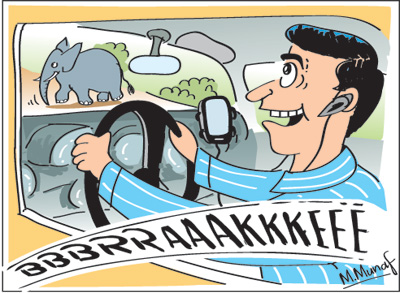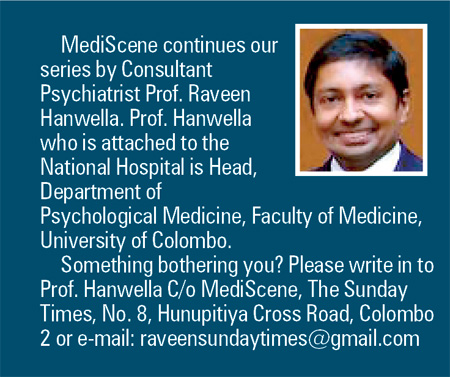Paying attention could save your life
“Distraction is a lot like water: First refreshing, then exhausting, and, finally, fatal.” -Author unknown
I thought this week I will take a departure from writing about mental illness, and bring to the attention of the reader, important facts about attention and distraction in humans. In my article I will focus on the use of mobile phones. The message however, is that distraction in any form could be deadly.
 Daniel Simons is a professor of psychology and a world authority on attention or rather inattention in humans. His first video on inattention is one of the most famous in psychology. I would urge you to watch it. It is freely available on YouTube. Just Google his name. I would like you to watch it before you continue reading this article. You may be surprised. In his book, The Invisible Gorilla: And Other Ways Our Intuitions Deceive Us, co-authored with Christopher Chabris, he writes with clarity on the scientific evidence regarding human attention and perception. I will highlight for you a few of the significant findings.
Daniel Simons is a professor of psychology and a world authority on attention or rather inattention in humans. His first video on inattention is one of the most famous in psychology. I would urge you to watch it. It is freely available on YouTube. Just Google his name. I would like you to watch it before you continue reading this article. You may be surprised. In his book, The Invisible Gorilla: And Other Ways Our Intuitions Deceive Us, co-authored with Christopher Chabris, he writes with clarity on the scientific evidence regarding human attention and perception. I will highlight for you a few of the significant findings.
We know that talking on the mobile phone while driving is dangerous and unlawful, and texting while driving even more. In some countries just holding a phone in one hand while driving is an offence. We think if drivers obey the law and use hands-free kits it is safe. But studies done in the US (no data available for Sri Lanka) show that 23% of car crashes are due to cell phone use including the use of hands-free kits. How is this possible? Unfortunately the law is based on the misunderstanding that phone use during driving is dangerous because you are then using only one hand to drive. This is not true.
Studies show that an experienced driver, especially if driving an automatic vehicle, can drive safely using one hand. Then why is phone use during driving so dangerous?
To answer the question let us go back to the classic experiment by Daniel Simons (I hope you have watched the video by now, otherwise what follows will be a spoiler). The experimenters asked a group of people to watch a short video of two teams of people playing basketball. Those watching were asked to count how many times the team wearing white passed the ball ignoring the passes of the black team. But psychologists are sly (when doing experiments). Simons was not really interested in the number of passes. What he was really interested in was whether those watching would notice a person in a full-body gorilla suit, who enters the room from the right, walks into the centre of the game, thumps her chest, and exits on the left. The gorilla is visible on the scene for 9 seconds. What he found was remarkable. More than half the people did not notice the gorilla! By the way did you notice the gorilla? When I first saw this film I did not either.
 When their error was pointed out, people were shocked. They could not quite believe that they could miss a gorilla even when looking directly at it. The experimenters tracked the eye movements of those watching and showed that even those looking directly at the gorilla failed to spot it. That is why when driving, even if you are looking straight at the road and keeping both hands on the wheel, you can miss even a gorilla (in Sri Lanka it would be an elephant) walking across the road, if you are sufficiently distracted. The reality is that are brains are never fully aware of our surroundings and anything that adds to the distraction will reduce this awareness even further.
When their error was pointed out, people were shocked. They could not quite believe that they could miss a gorilla even when looking directly at it. The experimenters tracked the eye movements of those watching and showed that even those looking directly at the gorilla failed to spot it. That is why when driving, even if you are looking straight at the road and keeping both hands on the wheel, you can miss even a gorilla (in Sri Lanka it would be an elephant) walking across the road, if you are sufficiently distracted. The reality is that are brains are never fully aware of our surroundings and anything that adds to the distraction will reduce this awareness even further.
That is why laws banning the use of hand-held phones will not solve the problem. What makes phoning and driving dangerous is not the physical limitation but the limitation of our brain capacity. Experiments repeatedly show that phoning with a hands-free kit is no safer than holding the phone in the hand. In fact it has been shown that both have the same effect as driving under the influence of alcohol. In spite of this evidence very few countries have passed laws banning the use of hands-free kits.
Even if they were to do so, enforcing the legislation would be a challenge, especially if people are using the Bluetooth link now found on most modern vehicles. Paradoxically the current laws allowing the use of hands free kits may actually encourage people to use their mobile phones even more while driving lulling them into a sense of false security. Unfortunately legislation is often based on intuition rather than on established science. If it were based on science then talking on the mobile phone with or without a hands-free kit would be banned.
What about other distractions while driving? Is it distracting to have the person sitting in your passenger seat talk to you while driving? Again research shows that if it is an adult, especially a person who can drive, he or she will instinctively know to stop talking when the driver has do a careful manoeuvre. In fact an adult in the passenger seat provides a second pair of eyes and overall increases driving safety.
Children are another matter, they will happily keep playing and distract the driver at crucial moments. Children playing in the backseat are even more distracting as their intrusions on the driver’s attention could be quite unexpected. So please pull out those forgotten rear seat belts, strap down your children and please, please don’t have them in your driving seat like I saw the other day. A charming sight may be but it gave me the chills. In addition to terrible distraction of the driver if the air bag were to go off a few inches from the child’s chest he would have been instantly killed.
What about distractions when not driving? The fact is our brains are not wired for multitasking. Neuroscientists have consistently shown that when the brain tries to multitask its efficiency drops. People who flit from one task to another, who feel they are getting a lot of work done, actually do less. But I will write more on the subject in a future article. If you are on foot, crossing a road is a dangerous task. So switch off your cell phones when you do. Even if you are not on the phone keep your ears pricked and your eyes open when in potentially dangerous situations.
Please pay attention and it just might save your life!


